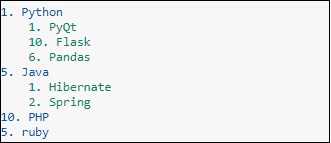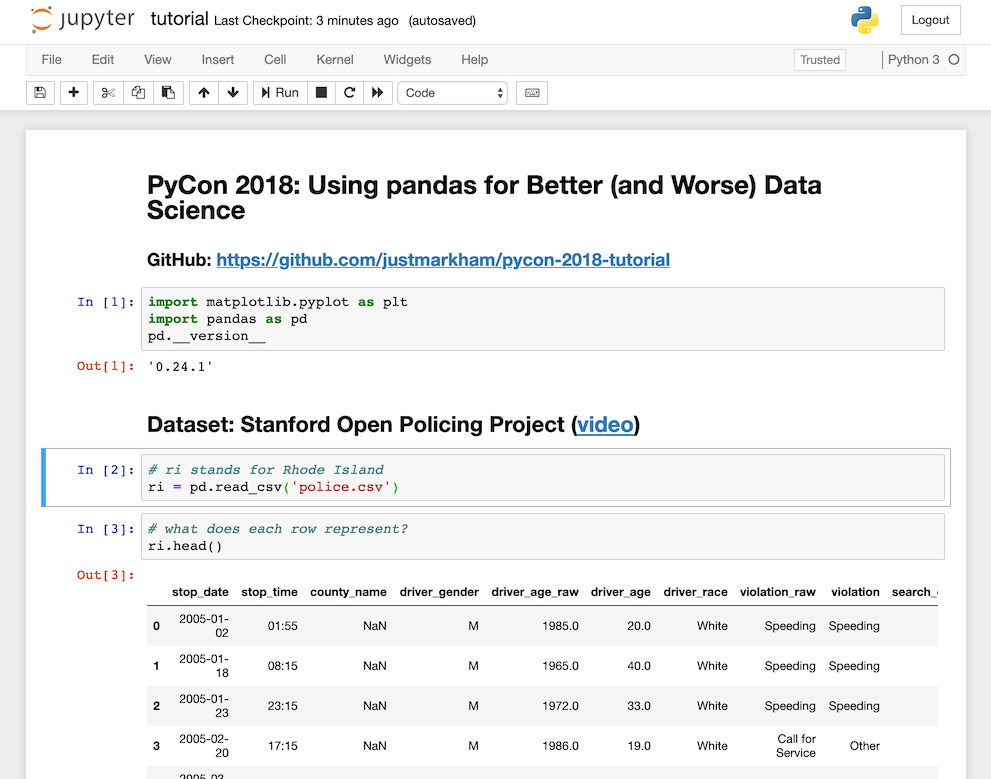Jupyter Markdown Cell
Jupyter Notebook is a great tool for data analysis. And one of its greatest features is that you can easily combine runnable code with rich-text annotations. Markdown cells that contain such annotations support both HTML and Markdown syntax.
I'm trying to change the font size of the juypter lab markdown cells so they match the cells when I set a List like that:no matter what I do, I cannot change the fontsize. Jupyter 노트북에 수학 공식을 작성하고 싶습니다. 라텍스는 마크 다운으로 만드는 간단한 방법 인 것 같습니다. 나는 여러 링크를 겪었지만 모두 그들에게. Vscode jupyter notebook markdown Please make the first cell in your. Ile be a Markdown cell that says “CMSC / Math 207 Homework 1” and your name. Working with Jupyter code cells in the Python Interactive window.
Personally I prefer # Header (markdown syntax) to <h1>Header</h1> (HTML syntax) in my notebook’s cells as the former looks more human. So I use markdown syntax more often and a concise cheat sheet for Jupyter Notebook markdown is what I was missing for a long time. Yes, I’m aware of such comprehensive cheat sheets like this and this, they are great but too verbal and it’s hard to print them on one page to have it easily accessible.
Eventually, I decided to gather all crucial points of the markdown syntax that are actual for Jupyter notebook and combine them in a concise cheat sheet that I present to you. It doesn’t explain much but should be useful if you simply forgot something. Click the picture to download the PDF version.
I didn’t get into the details of LaTeX syntax (see the penultimate cell in the cheat sheet with the square root of k) since it’s well described here (get ready, it’s a very long document) and you can even download a pretty good cheat sheet here.
Learning Objectives
- Explain what the
Markdownformat is. - Describe the role of
Markdownfor documentation of earth data science workflows. - Use
Markdownsyntax inJupyter Notebookto:- Create headers and lists
- Bold and italicize bold text
- Render images and create hyperlinks to web pages
What is Markdown?
Markdown is a human readable syntax (also referred to as a markup language) for formatting text documents. Markdown can be used to produce nicely formatted documents including PDFs and web pages.
When you format text using Markdown in a document, it is similar to using the format tools (e.g. bold, heading 1, heading 2) in a word processing tool like Microsoft Word or Google Docs. However, instead of using buttons to apply formatting, you use syntax such as **this syntax bolds text in markdown** or # Here is a heading.
Markdown syntax allows you to format text in many ways, such as making headings, bolding and italicizing words, creating bulleted lists, adding links, formatting mathematical symbols and making tables. These options allow you to format text in visually appealing and organized ways to present your ideas.
You can use Markdown to format text in many different tools including GitHub.com, R using RMarkdown, and Jupyter Notebook, which you will learn more about this page.
Data Tip: Learn more about how you can use Markdown to format text and document workflows in a variety of tools.
Markdown in Jupyter Notebook
A great benefit of Jupyter Notebook is that it allows you to combine both code (e.g. Python) and Markdown in one document, so that you can easily document your workflows.
A Jupyter Notebook file uses cells to organize content, and it can contain both cells that render text written using the Markdown syntax as well as cells that contain and run Python code.
Thus, you can use a combination of Markdown and Python code cells to organize and document your Jupyter Notebook for others to easily read and follow your workflow.
Data Tip: Learn more about Markdown for Jupyter Notebook.
If you render your Jupyter Notebook file to HTML or PDF, this Markdown will appear as formatted text in the output document.
Jupyter Markdown Cell Reference
Data Tip: In fact, this web page that you are reading right now is generated from a Markdown document! On this page, you will learn the basic syntax of Markdown.
Benefits of Markdown for Earth Data Science
Being able to include both Markdown and code (e.g. Python) cells in a Jupyter Notebook file supports reproducible science by allowing you to:
- Document your workflow: You can add text to the document that describes the steps of your processing workflow (e.g. how data is being processed and what results are produced).
- Describe your data: You can describe the data that you are using (e.g. source, pre-processing, metadata).
- Interpret code outputs: You can add some text that interprets or discusses the outputs.
all in one document!
When used effectively, Markdown documentation can help anyone who opens your Jupyter Notebook to follow, understand and even reproduce your workflow.
Format Text in Jupyter Notebook with Markdown
Markdown Cells in Jupyter Notebook
In the previous chapter on Jupyter Notebook, you learned how to add new Markdown cells to your Jupyter Notebook files using Menu tools and Keyboard Shortcuts to create new cells.
| Function | Keyboard Shortcut | Menu Tools |
|---|---|---|
| Create new cell | Esc + a (above), Esc + b (below) | Insert→ Insert Cell Above OR Insert → Insert Cell Below |
| Copy Cell | c | Copy Key |
| Paste Cell | v | Paste Key |
You also learned how to change the default type of the cell by clicking in the cell and selecting a new cell type (e.g. Markdown) in the cell type menu in the toolbar. Furthermore, you learned that in a Jupyter Notebook file, you can double-click in any Markdown cell to see the syntax, and then run the cell again to see the Markdown formatting.
Note: if you type text in a Markdown cell with no additional syntax, the text will appear as regular paragraph text. You can add additional syntax to that text to format it in different ways.
On this page, you will learn basic Markdown syntax that you can use to format text in Jupyter Notebook files.
Section Headers
You can create a heading using the pound (#) sign. For the headers to render properly, there must be a space between the # and the header text.
Heading one is denoted using one # sign, heading two is denoted using two ## signs, etc, as follows:
Here is a sample of the rendered Markdown:
Heading Three
Heading Four
Note: the titles on this page are actually formatted using Markdown (e.g. the words Section Headers above are formatted as a heading two).

Lists
You can also use Markdown to create lists using the following syntax:
It will render as follows:
- This is a bullet list
- This is a bullet list
- This is a bullet list
- And you can also create ordered lists
- by using numbers
- and listing new items in the lists
- on their own lines
Notice that you have space between the * or 1. and the text. The space triggers the action to create the list using Markdown.
Bold and Italicize

You can also use ** to bold or * to italicize words. To bold and italicize words, the symbols have to be touching the word and have to be repeated before and after the word using the following syntax:
It will render as follows:
These are italicized words, not a bullet listThese are bold words, not a bullet list
- This is a bullet item with bold words
- This is a bullet item with italicized words
Highlight Code
If you want to highlight a function or some code within a plain text paragraph, you can use one backtick on each side of the text like this:
which renders like this:
Here is some code!
The symbol used is the backtick, or grave; not an apostrophe (on most US keyboards, it is on the same key as the tilde (~)).
Horizontal Lines (Rules)

You can also create a horizontal line or rule to highlight a block of Markdown syntax (similar to the highlighting a block of code using the backticks):
which renders like this:
Here is some important text!
Hyperlinks
You can also use HTML in Markdown cells to create hyperlinks to websites using the following syntax:
<a href='url' target='_blank'>hyperlinked words</a>
You can identify the words that will be hyperlinked (i.e. prompt a web page to open when clicked) by replacing hyperlinked words in the example above.
For example, the following syntax:
Our program website can be found at <a href='http://earthdatascience.org' target='_blank'>this link</a>.
will render as follows with this link as the hyperlinked words:

Our program website can be found at this link.
Render Images
You can also use Markdown to link to images on the web using the following syntax:

The alt text is the alternative text that appears if an image fails to load on webpage; it is also used by screen-reading tools to identify the image to users of the screen-reading tools.
For example, the following syntax:

will render as follows with an alt text of Markdown Logo is here.:
Local Images Using Relative Computer Paths
You can also add images to a Markdown cell using relative paths to files in your directory structure using:


For relative paths (images stored on your computer) to work in Jupyter Notebook, you need to place the image in a location on your computer that is RELATIVE to your .ipynb file. This is where good file management becomes extremely important.
For a simple example of using relative paths, imagine that you have a subdirectory named images in your earth-analytics directory (i.e. earth-analytics/images/).
If your Jupyter Notebook file (.ipynb) is located in root of this directory (i.e. earth-analytics/notebook.ipynb), and all images that you want to include in your report are located in the images subdirectory (i.e. earth-analytics/images/), then the path that you would use for each image is:
images/image-name.png
If all of your images are in the images subdirectory, then you will be able to easily find them. This also follows good file management practices because all of the images that you use in your report are contained within your project directory.
Data tip: There are many free Markdown editors out there! The atom.io editor is a powerful text editor package by GitHub, that also has a Markdown renderer that allows you to preview the rendered Markdown as you write.
Jupyter Markdown Cell Background Color
Additional Resources
Jupyter Markdown Cell Phone
Practice Your Markdown Skills
Jupyter Markdown Cell Code
Open or create a new
Jupyter Notebookfile.- Add a new
Markdowncell and include:- A title for the notebook (e.g.
Intro to Earth Analytics - Chapter Four) - A bullet list with:
- A bold word for
Author:and then add text for your name. - A bold word for
Date:and then add text for today’s date.
- A bold word for
- A title for the notebook (e.g.
- Add another
Markdowncell and include:- A list of your top three favorite foods (e.g. blueberries, chocolate bars, avocados).
- Italicize the first item in your list.
- Add a hyperlink (i.e. webpages) for the second item in your list (include the name of the food in the title of the hyperlink).
- Add an image for the last item in your list (include the name in the alt text of the image).
- A list of your top three favorite foods (e.g. blueberries, chocolate bars, avocados).
